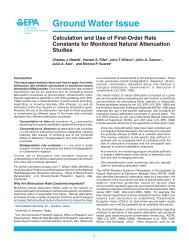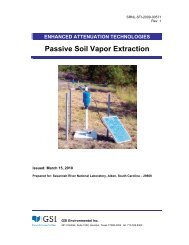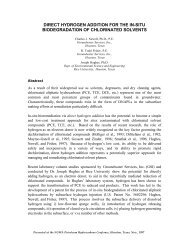Indoor Air as a Source of VOC Contamination in Shallow Soils - GSI ...
Indoor Air as a Source of VOC Contamination in Shallow Soils - GSI ...
Indoor Air as a Source of VOC Contamination in Shallow Soils - GSI ...
Create successful ePaper yourself
Turn your PDF publications into a flip-book with our unique Google optimized e-Paper software.
104 T. E. McHugh et al.Because model<strong>in</strong>g failed to identify the vapor <strong>in</strong>trusion impacts at the Colorado sites(Renner, 2002), the US EPA draft guidance documents have a reduced reliance on modelsfor pathway screen<strong>in</strong>g and favor direct me<strong>as</strong>urements to evaluate the potential for vapor<strong>in</strong>trusion at corrective action sites (Schuver, 2003). In addition, a number <strong>of</strong> state and localregulatory agencies have recently issued new or updated guidance that similarly emph<strong>as</strong>izesfield me<strong>as</strong>urements <strong>in</strong>stead <strong>of</strong> model<strong>in</strong>g for the evaluation <strong>of</strong> the vapor <strong>in</strong>trusion pathway(WIDHFS, 2003; San Diego County, 2004; PADEP, 2004).In its current form, the US EPA Vapor Intrusion Guidance (US EPA, 2002) recommendsa tiered approach for evaluation <strong>of</strong> the vapor <strong>in</strong>trusion pathway at corrective action sitesconsist<strong>in</strong>g <strong>of</strong>: i) a prelim<strong>in</strong>ary pathway evaluation b<strong>as</strong>ed on the presence <strong>of</strong> a volatilesource and receptor, ii) an evaluation <strong>of</strong> volatile organic compound (<strong>VOC</strong>) concentrationsus<strong>in</strong>g generic and “semi-site-specific” screen<strong>in</strong>g concentrations, and iii) a site <strong>in</strong>vestigationto evaluate vapor <strong>in</strong>trusion by direct me<strong>as</strong>urement and limited mathematical model<strong>in</strong>g.For anumber <strong>of</strong> common <strong>VOC</strong>s such <strong>as</strong> trichloroethene (TCE) and benzene, both thegeneric and the “semi-site-specific” groundwater vapor <strong>in</strong>trusion screen<strong>in</strong>g limits proposedby the US EPA are equal to dr<strong>in</strong>k<strong>in</strong>g water Maximum Contam<strong>in</strong>ant Levels (i.e., 5 ug/L)—a“screen<strong>in</strong>g level” that is likely to screen out very few groundwater corrective action sites.As a result, a majority <strong>of</strong> corrective action sites where US EPA guidance is applied willrequire field-b<strong>as</strong>ed site <strong>in</strong>vestigations to evaluate the potential for vapor <strong>in</strong>trusion impacts.However, site-specific evaluations <strong>of</strong> potential vapor <strong>in</strong>trusion, particularly those <strong>in</strong>volv<strong>in</strong>gthe me<strong>as</strong>urement <strong>of</strong> <strong>in</strong>door air <strong>VOC</strong> levels, can prove to be highly problematic due to thepresence <strong>of</strong> common <strong>in</strong>door sources <strong>of</strong> <strong>VOC</strong>s already present with<strong>in</strong> build<strong>in</strong>gs (McHughet al., 2004). Average background <strong>in</strong>door air concentrations <strong>of</strong> many common <strong>VOC</strong>s <strong>in</strong>build<strong>in</strong>gs located away from corrective action sites exceed US EPA screen<strong>in</strong>g concentrationsfor <strong>in</strong>door air (see Table 1). Therefore, for <strong>VOC</strong>s <strong>as</strong>sociated with common <strong>in</strong>door sources,the direct me<strong>as</strong>urement <strong>of</strong> concentrations <strong>in</strong> <strong>in</strong>door air is <strong>of</strong>ten not an effective method foridentify<strong>in</strong>g vapor <strong>in</strong>trusion impacts.US EPA and many state regulatory agency guidance documents recommend belowfoundationvapor sampl<strong>in</strong>g <strong>as</strong> a key element <strong>of</strong> site <strong>in</strong>vestigations to evaluate <strong>in</strong>door air (USEPA, 2002; WIDHFS, 2003; San Diego County, 2004; PADEP, 2004). In an attempt to elim<strong>in</strong>atethe confound<strong>in</strong>g effect <strong>of</strong> <strong>in</strong>door <strong>VOC</strong> sources, these guidance documents typicallyrecommend below-foundation vapor sampl<strong>in</strong>g prior to sampl<strong>in</strong>g <strong>of</strong> <strong>in</strong>door air (e.g., Page 38<strong>of</strong> US EPA, 2002). If no <strong>VOC</strong>s are detected <strong>in</strong> the below-foundation vapor samples, thenmigration <strong>of</strong> <strong>VOC</strong>s from the subsurface through the build<strong>in</strong>g foundation is not consideredto be a problem. However, if <strong>VOC</strong>s are detected <strong>in</strong> the below-foundation samples, then migrationfrom the subsurface is <strong>as</strong>sumed to be occurr<strong>in</strong>g, and further evaluation is requiredto determ<strong>in</strong>e the extent <strong>of</strong> the subsurface impact. These guidance documents are predicatedon the <strong>as</strong>sumption that <strong>VOC</strong>s detected <strong>in</strong> below-foundation samples have orig<strong>in</strong>ated fromdeeper with<strong>in</strong> the subsurface and are migrat<strong>in</strong>g towards the build<strong>in</strong>g. However, b<strong>as</strong>ed onthe results <strong>of</strong> model<strong>in</strong>g and field analyses, detection <strong>of</strong> <strong>VOC</strong>s <strong>in</strong> below-foundation samplesis not sufficient to conclude that <strong>VOC</strong>s are migrat<strong>in</strong>g from the subsurface towards a build<strong>in</strong>g.In some c<strong>as</strong>es, <strong>VOC</strong>s detected <strong>in</strong> below-foundation samples may have orig<strong>in</strong>ated from<strong>in</strong>door sources and are migrat<strong>in</strong>g downward through the build<strong>in</strong>g foundation by diffusionor advection.Commonly referenced conceptual models <strong>of</strong> vapor <strong>in</strong>trusion address <strong>VOC</strong> migrationfrom the subsurface <strong>in</strong>to build<strong>in</strong>gs but do not consider the potential for <strong>VOC</strong> migration frombuild<strong>in</strong>gs <strong>in</strong>to the subsurface (US EPA, 2002; Johnson and Ett<strong>in</strong>ger, 1991; Parker, 2003).However, the advective and diffusive forces that lead to the migration <strong>of</strong> <strong>VOC</strong>s from thesubsurface <strong>in</strong>to build<strong>in</strong>gs are equally capable <strong>of</strong> caus<strong>in</strong>g migration <strong>of</strong> <strong>VOC</strong>s from build<strong>in</strong>gs






